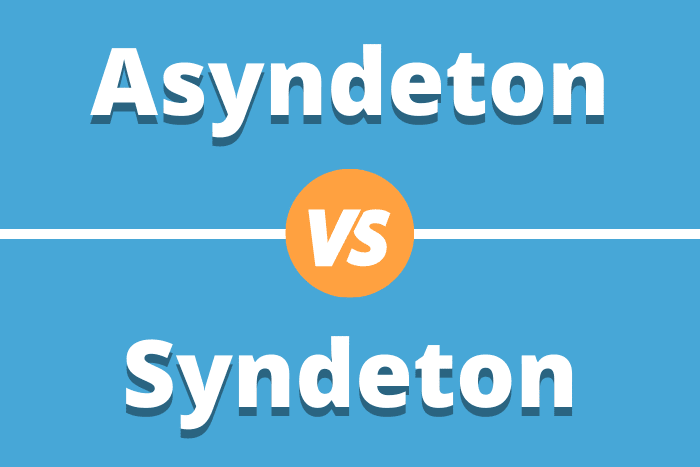Great questions.
As a writer, I’m always looking for ways to make my writing more dynamic, interesting, and powerful.
Asyndeton can do just that!
Writers have used this literary device for thousands of years to awaken their audience and grab their attention. It’s even been used to inspire nations around the world.
Ready to see how?
First, I’ll begin with the asyndeton definition.

What is Asyndeton?
Asyndeton is a literary device that excludes conjunctions (and, or, but, for, nor, so, yet) to add emphasis to sentences, phrases or clauses.
For example, Julius Caesar used asyndeton when he famously wrote the phrase, “Veni, Vidi, Vici” or “I came, I saw, I conquered.”
Read that quote again.
Do you notice how powerful it sounds?
Caesar could’ve said, “I came, I saw, and I conquered,” but the deliberate omission of “and” worked better.
If Caesar had used a conjunction, that would have been an example of syndeton.
And by the way, if you’re worried about “proper grammar”, asyndeton is a valid stylistic choice rather than a grammatical error (though it is unconventional.)
The Difference Between Asyndeton and Syndeton

Unlike asyndeton, syndeton uses conjunctions to join words, short phrases, or related clauses.
For instance, compare these two examples:
- Asyndeton (without conjunction): “Reduce, reuse, recycle.”
- Syndeton (with conjunction): “Reduce, reuse, and recycle.”
Do you see the difference?
Syndeton slows you down but flows nicely. Asyndeton speeds you up, is punchier, and adds emphasis.
They create opposite effects.
Makes sense, right?
Now let me walk you through a few more asyndeton examples…
18 Examples of Asyndeton That’ll Add Emphasis to Your Writing
First things first:
Asyndeton comes from the Greek word asyndetos, meaning “unconnected.” It’s unconnected because it excludes the conjunctions that normally join phrases.
Although asyndeton was first discovered in Greek and Latin literature, today, it’s used across various languages.
We commonly see it in speeches, songs, movies, and English literature.
Let’s explore some examples from literature first.
Asyndeton Examples in Literature

Joseph Conrad used asyndeton in his novel Heart of Darkness:
-
“The air was thick, warm, heavy, sluggish.“
Do you see how there is more drama to the sentence without the conjunction?
We also see that dramatic effect added in William Golding’s Lord of the Flies:
-
“We saw no houses, no smoke, no footprints, no boats, no people.”
Both Conrad and Golding used asyndetons to emphasize their points.
Charles Dickens was also a fan of this literary device.
For example, this entire paragraph from his novel, A Tale of Two Cities, is full of asyndetons:
-
“It was the best of times, it was the worst of times, it was the age of wisdom, it was the age of foolishness, it was the epoch of belief, it was the epoch of incredulity, it was the season of Light, it was the season of Darkness, it was the spring of hope, it was the winter of despair, we had everything before us, we had nothing before us, we were all going direct to Heaven, we were all going direct the other way . . .”
And here is another example in Charles Dickens’ A Tale of Two Cities, after the climax of the story:
-
“My friend is dead, my neighbor is dead, my love, the darling of my soul, is dead.”
Now remember this:
Asyndeton isn’t a new concept. Writers have used it for thousands of years to create suspense and add emphasis.
For example, William Shakespeare used it in his play, Julius Caesar:
-
“O mighty Caesar! Dost thou lie so low?
Are all thy conquests, glories, triumphs, spoils,
Shrunk to this little measure? Fare thee well.”
This asyndeton emphasized that despite Julius Caesar’s victories, he still wasn’t immune to death.
James Joyce was no stranger to using asyndetons for emphasis, either.
Here’s an example from his novel A Portrait of the Artist as a Young Man:
-
“Consciousness of place came ebbing back to him slowly over a vast tract of time unlit, unfelt, unlived…”
Did you notice how his ending has a faster rhythm with the asyndeton?
That’s the goal.
Asyndetons also speed up the rhythm in music. This brings us to our next topic…
Asyndeton Examples in Songs

It’s known as one of the greatest songs of all time.
It’s played in stadiums all over the world. Audiences instinctively fall into its infectious beat.
What song am I talking about?
Queen’s “We Will Rock You” of course.
Take the opening verse, for example. It features this asyndeton:
-
Buddy, you’re a boy, make a big noise
Playing in the street, gonna be a big man someday
Queen left out the connectives “and” to make this lyric more impactful.
And here’s another example from the same song:
-
Buddy, you’re a young man, hard man
Shouting in the street, gonna take on the world someday
And he does it again here:
-
Buddy, you’re an old man, poor man
Pleading with your eyes, gonna get you some peace someday
Have a listen to this song and pay attention to how the asyndetons pack a powerful punch:
Now I don’t know about you, but that song has been stuck in my head for years. Think about it. Artists purposely use asyndetons to make their songs more memorable.
Another reason?
It helps with their writing style, flow, and beat of the music. For example, Nicki Minaj uses it in her song “Fly”:
-
I came to win, to fight, to conquer, to thrive.
I came to win, to survive, to prosper, to rise.
It doesn’t stop there.
Asyndeton is a great way to emphasize emotion. Rafael Bolivar Coronado did that in his song, “Alma Llanera”:
-
I love, I cry, I sing, I dream
with passion carnations, with passion carnations.
And you know what else?
It’s a clever way to grab someone’s attention.
For example, check out this commercial:
The song in this commercial is a play off the famous “Camp Granada” by Allan Sherman.
The opening lyrics go like this:
-
Hello mother, hello father.
Fleas, ticks, mosquitoes really bother.
There is no conjunction between fleas, ticks, and mosquitos, so it flows well and sticks in your head.
That’s pretty straightforward, right?
But we’re not done yet.
Asyndetons can also make speeches more memorable.
In fact, Aristotle said it’s more effective in spoken oratory than in writing.
Want to see how?
Examples of Asyndeton in Speeches

There’s no doubt about it.
Winston Churchill’s speeches inspired the world.
One of his most famous quotes includes an asyndeton:
-
“We shall go on to the end. We shall fight in France, we shall fight with growing confidence and growing strength in the air . . . we shall never surrender.”
Powerful, isn’t it?
This very speech encouraged the British to rise against Nazi Germany and keep fighting.
Have a listen for yourself:
Churchill also used this rhetoric in other quotes:
-
“All is over. Silent, mournful, abandoned, broken, Czechoslovakia recedes into darkness.”
And you know what else?
He included sensory words alongside the asyndeton to paint a strong scene for his audience.
The man knew what he was doing.
But Churchill isn’t the only one.
Abraham Lincoln, JFK, Martin Luther King, and Steven Jobs all used asyndetons as a rhetorical device to persuade the nation.
We heard it from Lincoln’s Gettysburg Address:
-
“…and that government of the people, by the people, for the people shall not perish from the Earth.”
We heard it from JFK’s inauguration speech:
-
“We shall pay any price, bear any burden, meet any hardship, support any friend, oppose any foe to assure the survival and the success of liberty.”
MLK used it in his famous “I Have a Dream” speech:
-
“We will be able to work together, to pray together, to struggle together, to go to jail together, to stand up for freedom together knowing that we will be free one day.”
And finally, Steve Jobs used it in his “Think Different” campaign:
-
“Here’s to the crazy ones, the misfits, the rebels, the troublemakers, the ones who see things differently.”
Watch this video to see how influential Steve Job’s campaign was:
Why Use Asyndeton?
Let me ask you:
Do you want your writing to stand out? To be more interesting, powerful, memorable?
Of course you do.
You’re a good writer. A writer who adds emphasis and emotion to your prose. One who knows how to grab your reader’s attention.
And more than anything?
You’re a good writer who tries new literary techniques to improve your writing skills.
After all, that’s how we get better.
We read, write, learn.
See what I just did there?
Time to Make Your Own Asyndeton Examples
Now it’s your turn to use asyndetons in your written prose.
So where do you start?
Begin by paying attention to the asyndeton examples you find in books, movies, or songs. When you find ones that resonate with you, add them to your swipe file for writing inspiration.
Here are a few of my favorites:
- Eat. Pray. Love.
- I came, I saw, I conquered.
- Reduce, reuse, recycle.
Finally, use the inspiration you get from your writing swipe file to create your own asyndetons.
It’ll command your reader’s attention and make your content more dynamic.
Use it well.








